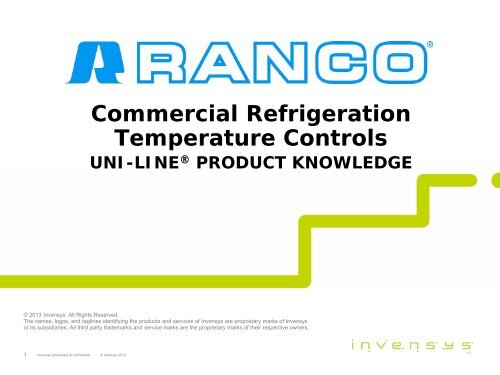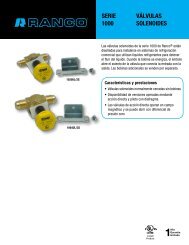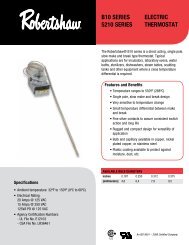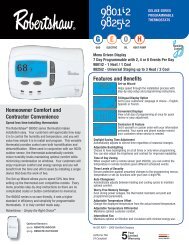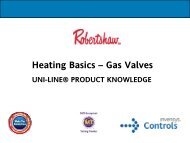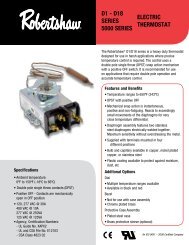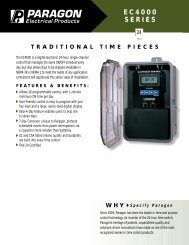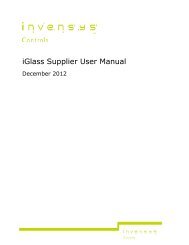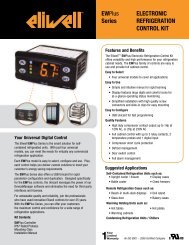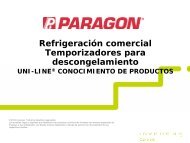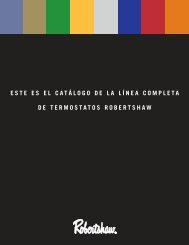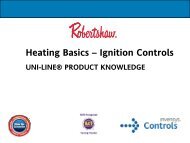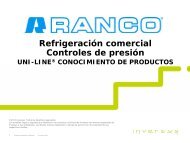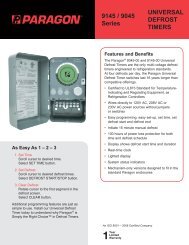Commercial Refrigeration Temperature Controls - Invensys Controls
Commercial Refrigeration Temperature Controls - Invensys Controls
Commercial Refrigeration Temperature Controls - Invensys Controls
You also want an ePaper? Increase the reach of your titles
YUMPU automatically turns print PDFs into web optimized ePapers that Google loves.
What Are The Differences Between AirConditioning and <strong>Commercial</strong> <strong>Refrigeration</strong>?• Scientific principals are same, howeverrefrigeration systems are:– Operation Time 24 / 7– Defrost Cycles– Load Changes• Energy Conservation Important on A/C Systems– However, more critical on <strong>Commercial</strong> <strong>Refrigeration</strong>Applications3<strong>Invensys</strong> proprietary & confidential© <strong>Invensys</strong> 2013
Technical Terms and Definitions• PSIG Pounds per Square Inch Gauge• PSIA Pounds per Square Inch Absolute• BTU British Thermal Unit• Conduction Flow of heat with solids• Convection Flow of heat with fluids (or gas)• Radiation Flow of heat with air (or space)• Superheat Heat added to a refrigerant in the evaporator just after it changesfrom liquid to gas up to the compressor• Sub Cooling The difference in temperature in the condenser just after itchanges from gas to liquid up to the expansion device• TXV Thermal Expansion Valve• Compressor A pump or mechanical device that increases the pressure of gases4<strong>Invensys</strong> proprietary & confidential© <strong>Invensys</strong> 2013
Technical Terms and Concepts• Refrigerant Thermodynamics - The transfer of heat from a placewhere it’s not wanted to a place where it’s not objectionable.• Hot Gas Defrost System – Hot refrigerant is pumped directly to theevaporator tubing. Defrost time is usually 5 to 10 minutes.• Rules of Heat– Heat always moves from a warmer to a cooler surface– Heat always moves in three ways;• conduction, convection, or radiation– When a refrigerant substance boils, it absorbs heat– When a refrigerant substance condenses, it rejects heat5<strong>Invensys</strong> proprietary & confidential© <strong>Invensys</strong> 2013
<strong>Refrigeration</strong> SystemPressure ControlDefrost Control<strong>Temperature</strong> ControlCold <strong>Controls</strong>66<strong>Invensys</strong> proprietary & confidential © <strong>Invensys</strong> 2013<strong>Invensys</strong> proprietary & confidential © <strong>Invensys</strong> 2013
Differentials• Narrow Differential (10°F or less)– When a narrow differential is desired– Closely maintain within 5 to 6°F– Typically used for air sensing applications• Wide Differential (10°F or more)– Required due to swing in evaporator temperaturesbetween compressor ON and OFF– Household refrigerators and room air conditioners– Typically used to sense evaporator coil temperature7<strong>Invensys</strong> proprietary & confidential© <strong>Invensys</strong> 2013
Cut-In And Cut-Out Cooling Operation• Cut-out mode: Differential is above setpoint– Output relay energizes when temperature rises to setpoint plusthe differential value– When temperature drops to setpoint, the relay de-energizes• Cut-in mode: Differential is below setpoint– The output relay energizes when the temperature rises to setpoint– When the temperature drops to setpoint minus the differentialvalue, the relay de-energizes8<strong>Invensys</strong> proprietary & confidential© <strong>Invensys</strong> 2013
Terms And Definitions Continued• Constant cut-in controls (A30 series)– Designed for frost free refrigerators– Used in coolers and display cases• Differential cut-in controls (A12 series)– This type of control offers an adjustable differential– Rotating the dial indicator to the colder position changes thecut-out temperature only and widens the differential• Capillary tube– The gas within the capillary tube reacts to temperature changes– Actuates the power element diaphragm to trip the togglemechanism9<strong>Invensys</strong> proprietary & confidential© <strong>Invensys</strong> 2013
Cut-In And Cut-Cut Cooling ExampleDesired Temp(Cut-Out Mode)Desired Temp(Cut-In Mode)10<strong>Invensys</strong> proprietary & confidential© <strong>Invensys</strong> 2013
Terms and Concepts Continued• Two Types of Cold <strong>Controls</strong>:– Constant Differential– Constant Cut-in• Applications– Water coolers– Beverage dispensers– Display cases• Constant Differential also called “straight range controls”• Designed for household refrigerators and freezers11<strong>Invensys</strong> proprietary & confidential© <strong>Invensys</strong> 2013
Constant Cut-In With Dial12<strong>Invensys</strong> proprietary & confidential© <strong>Invensys</strong> 2013
Capillary Sensing Bulbs• The Capillary-only bellows sense from the coldest exposure point• The Capillary with bulb senses from the bulb only• The bulb portion of the A22 & A30 capillaries must be mountedwith tip end pointing upward within 65° of vertical• Sensing elements of A22 & A30 contain saturated vapor liquidrefrigerant and are sensitive to barometric pressure changes• Sensing elements C12 & C17 contain liquid filled bulbs for accuratetemperature control• C12 & C17 bulbs may be oriented in any position13<strong>Invensys</strong> proprietary & confidential© <strong>Invensys</strong> 2013
Capillary Tube Mechanics14<strong>Invensys</strong> proprietary & confidential© <strong>Invensys</strong> 2013
Capillary Tube Electronics15<strong>Invensys</strong> proprietary & confidential© <strong>Invensys</strong> 2013
Capillary Only <strong>Temperature</strong> Control• Limited vapor-fill sensing element• Sense directly by the capillary• May be used where the desired sensing is at the coldest pointalong the capillary (including the control body itself)• Entire control located where it will sense fixture temperature16<strong>Invensys</strong> proprietary & confidential© <strong>Invensys</strong> 2013
Applications for <strong>Temperature</strong> <strong>Controls</strong>• Ice Machines• Display Cases• Reach-In Refrigerator/Freezers• Walk-In Refrigerator/Freezers• Beverage Coolers• Condensing Units17<strong>Invensys</strong> proprietary & confidential© <strong>Invensys</strong> 2013
Electronic <strong>Temperature</strong> Controller (ETC)• Electronic Accuracy• Wide Range (-30° to 220°F)• Wide Differential Selection• Easy Installation• Easy Programming• Clear <strong>Temperature</strong> Display• No Jumpers• Contractor Preferred• Sensor up to 400 Feet• Averages Multiple Sensors18<strong>Invensys</strong> proprietary & confidential© <strong>Invensys</strong> 2013
ETC ApplicationsIt Just Makes Sense• Retail store display freezers and reach-in coolers• Supermarket display cases for produce/meats• Retail store walk-in coolers and freezers• Boiler operating control (used as a thermostat)• Condenser fan cycling or staging• Cooling tower pump and fan control• Space and return air temperature control• Bulk milk coolers• Poultry houses and livestock barns19<strong>Invensys</strong> proprietary & confidential© <strong>Invensys</strong> 2013
Top Five Ranco ® ETC Movers• Microprocessor based electronic temperature control• Designed to provide ON and OFF control for commercial HVACRPart Number Voltage (AC) Stages EnclosureETC-111000-000 120/240 1 StandardETC-112000-000 24 1 StandardETC-212000-000 24 2 StandardETC-211000-000 120/240 2 StandardETC-141000-000 120/240 1 NEMA 4X20<strong>Invensys</strong> proprietary & confidential© <strong>Invensys</strong> 2013
Manufacturer ComparisonRanco ® Electronic <strong>Temperature</strong> Control is Easier to Use!• No jumpers required• Simple programmingJohnson A419• Short cycle protection• Optional external setpoint change switch• LED lights when relay energized• Includes 3 configuration jumpers• Hard to remember programming21<strong>Invensys</strong> proprietary & confidential© <strong>Invensys</strong> 2013
<strong>Temperature</strong> Control Manufacturers• Johnson <strong>Controls</strong> – Penn• White-Rodgers• Saganomia (Danfoss)• G.E. - Art series• Asian knock-offs• Sunne Peco• Ranco ® © <strong>Invensys</strong> 2013<strong>Invensys</strong> proprietary & confidential22
Installation for ETC Control• Mount unit to wall or flat surface• Review typical line voltage wiring diagram• Determine location of sensor• Program 4 simple steps23<strong>Invensys</strong> proprietary & confidential© <strong>Invensys</strong> 2013
Troubleshooting Error Messages• E1 appears when up or down keys are pressed– If E1 appears when no keys are being pressed, replace the control• E2 appears if control settings are not properly stored in memory– Check all settings and correct if necessary• EP appears when the probe is open, shorted or sensing atemperature that is out of range– Check if the sensed temp is out of range.– If not, check for probe damage by comparing it to a known ambient tempbetween -30° F and 220° F. Replace the probe if necessary.• EE appears if the EEPROM data has been corrupted– This condition cannot be field repaired. Replace control• CL appears if calibration mode has been entered.– Remove power to the control for at least five seconds. Reapply power.– If CL message still appears, replace control24<strong>Invensys</strong> proprietary & confidential© <strong>Invensys</strong> 2013
Applications For Cold <strong>Controls</strong>Ice Maker• Ice Bin Level Control• Ice Harvest• <strong>Commercial</strong> <strong>Refrigeration</strong>• Household• Water Coolers• A and CC Series• K and RC Series• 9500 Series Cold controls• 3030 Series are Uni-Kits25<strong>Invensys</strong> proprietary & confidential© <strong>Invensys</strong> 2013
Cold Control Sell SheetOrder Cold Control Sell Sheet• English and Spanish 150-230026<strong>Invensys</strong> proprietary & confidential© <strong>Invensys</strong> 2013
<strong>Commercial</strong> <strong>Refrigeration</strong> CatalogOrder <strong>Commercial</strong> <strong>Refrigeration</strong>Brochure with <strong>Temperature</strong> <strong>Controls</strong>:• 150-228227<strong>Invensys</strong> proprietary & confidential© <strong>Invensys</strong> 2013
Quiz Question #1What is the temperature range of the Ranco ® Electronic<strong>Temperature</strong> <strong>Controls</strong> (ETC)?A. -50°F to 0°FB. -30°F to 220°FC. -30°C to 220°C28<strong>Invensys</strong> proprietary & confidential© <strong>Invensys</strong> 2013
Quiz Question #2What voltages are available within the ETC family of products?A. 120V ACB. 240V ACC. 24V ACD. All of the above29<strong>Invensys</strong> proprietary & confidential© <strong>Invensys</strong> 4/18/2013
Website Tools: www.Uni-Line.comSearch partnumbersCrossReferenceClick here for more information30<strong>Invensys</strong> proprietary & confidential© <strong>Invensys</strong> 2013
When You Have Uni-Line ® QuestionsTelephone:Technical Service 1-800-445-8299Technical Service Fax 1-630-260-7294Customer Service 1-800-304-6563Customer Service Fax 1-800-426-0804Websites:Uni-Line ® Catalog:www.Uni-Line.comCross Reference: www.uni-line.com/modules/xref/xrefsearch.aspxGeneral Information for:Robertshaw ® , Paragon ® , Eliwell, Ranco ® , and Publication Zone ®www.<strong>Invensys</strong><strong>Controls</strong>.comwww.RobertshawTstats.comwww.ToolBox.<strong>Invensys</strong><strong>Controls</strong>.com<strong>Invensys</strong>, Robertshaw® Paragon®, Ranco®, Eliwell, Uni-Line ® , and Make the Connection are propriety marks of <strong>Invensys</strong> or its subsidiaries.All third party trademarks and service marks are the proprietary marks of their respective owners.© 2013 <strong>Invensys</strong> <strong>Controls</strong>. All rights reserved.31<strong>Invensys</strong> proprietary & confidential© <strong>Invensys</strong> 2013


